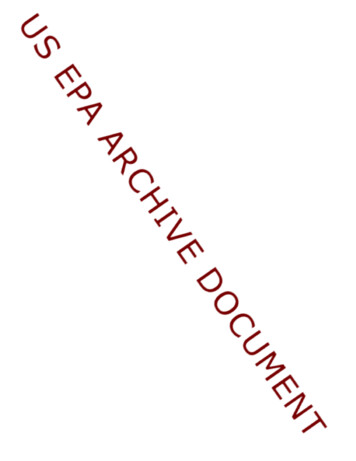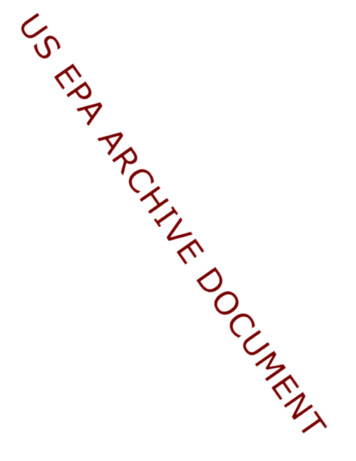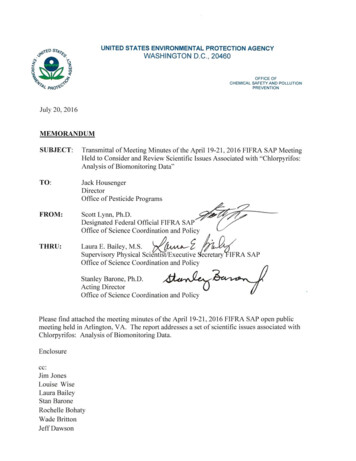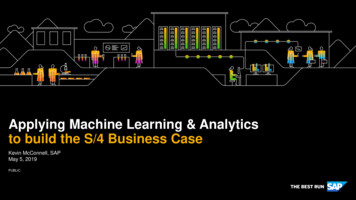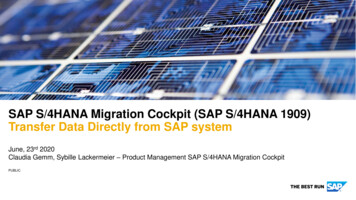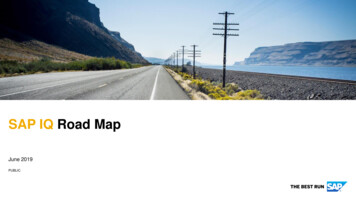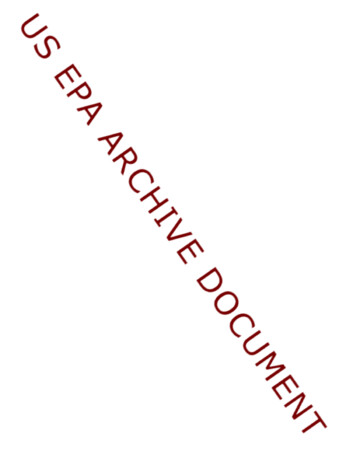
Transcription
FIFRA SCIENTIFIC ADVISORY PANEL (SAP)OPEN MEETINGREEVALUATION OF THE HUMAN HEALTH EFFECTSOF ATRAZINE:REVIEW OF NON-CANCER EFFECTS ANDDRINKING WATER MONITORING FREQUENCYDOCKET NUMBER: EPA-HQ-OPP-2010-0481UNITED STATES ENVIRONMENTALPROTECTION AGENCYCONFERENCE CENTER LOBBY LEVELONE POTOMAC YARD (SOUTH BUILDING)2777 SOUTH CRYSTAL DRIVEARLINGTON, VIRGINIA 22202SEPTEMBER 14, 20108:40 A.M.
FIFRA SCIENTIFIC ADVISORY PANEL 09/14/10 CCR#15732-51FIFRA SCIENTIFIC ADVISORY PANEL2MEETING3SEPTEMBER 14, 20104DR. JOSEPH BAILEY:2We'll get started5 here in just a few minutes as soon as everyone gets6 settled.7Okay, good morning, everyone.I'm Joe8 Bailey, and I want to welcome everyone to this FIFRA9 Scientific Advisory Panel meeting.This is our third10 meeting this year on atrazine, and the topic for this11 particular meeting is the Review of Non-Cancer Effects12 and Drinking Water Monitoring Frequency.13I particularly want to welcome the Panel14 and thank them for agreeing to participate in this15 meeting.And I just have a word, a few quick routine16 administrative remarks to make.I am serving as the17 DFO for the meeting, and I will be serving as liaison18 between EPA and the Panel.19And this is a Federal Advisory Committee20 within the Federal Advisory Committee Act, which means21 that the recommendations and advice that the Panel22 provides to EPA is purely recommendations and advice on23 science issues, and all regulatory matters are strictly24 the Agency decisions, of course, taking into account25 the recommendations and advice that the Panel gives.
FIFRA SCIENTIFIC ADVISORY PANEL 09/14/10 CCR#15732-513As far as the ethics regulations go, we2 kind of review the contradictdisclosure information3 that the Panel members have provided to ensure that all4 of our ethics regulations are complied with.5There is tomorrow on the Agenda,6 beginning I believe about mid-morning, an opportunity7 for public comment.That's one of the requirements for8 FACA held meetings is to provide an opportunity for9 public comment.10We do have a number of commenters who11 have requested time on the Agenda to hear their12 remarks.If there is anyone else who wishes to give13 remarks during the public-comment opportunity tomorrow,14 please let me know or one of the other people here from15 the SAP office.If you have not made arrangements16 prior to the meeting for public comments, we will ask17 that you limit your comments to five minutes on the18 Agenda.19As usual, we have a Public Docket20 created for this meeting, and the number should be at21 the top of everyone's Agenda.All of the background22 documents that have been provided to the Panel so far23 are in that document.24Some of them are sensitive materials25 that you must contact the docket and sign an
FIFRA SCIENTIFIC ADVISORY PANEL 09/14/10 CCR#15732-541 affirmation of nondisclosure as to those; but2 everything else should be available in the docket, and3 that will include all of the slide presentations that4 are made by EPA or public commenters.They are5 enclosed in the docket very shortly after that6 presentation, so they will be available as well.7And I think that covers everything I8 wanted to bring up.Again, thank you all for coming9 this morning, and I will now turn the mic to Chair of10 this meeting, Dr. Steve Heeringa.DR. STEVEN HEERINGA:11Thank you.Thank you very12 much, Joe, and welcome everyone to this 4-day meeting13 of the FIFRA Science Advisory Panel on the topic of Re14 Evaluation of the Human Health Effects of Atrazine:15 Review of Non-Cancer Effects and Drinking Water16 Monitoring Frequency.17As so indicated, I am Steve Heeringa of18 the University of Michigan.I am currently in for a19 short period as the chair of the FIFRA Scientific20 Advisory Panel.21I will be serving as Chair of these22 proceedings with no specific substantive expertise to23 contribute; but we have a very highly qualified Panel24 of experts, and so we look forward to this meeting and25 I thank them in advance and probably throughout this
FIFRA SCIENTIFIC ADVISORY PANEL 09/14/10 CCR#15732-551 meeting for their contributions.2But at this point, let's meet the Panel,3 beginning here on my left with Ken Portier.4DR. KENNETH PORTIER:Good morning, I'm5 Ken Portier, Director of Statistics at the American6 Cancer Society National Office in Atlanta.I am a7 biostatistician and member of the current Panel.8DR. JANICE CHAMBERS:I'm Jan Chambers;9 I'm a Professor in the College of Veterinary Medicine10 in Mississippi State University on pesticide11 toxicology, neurotoxicology and metabolism expertise,12 and I'm a member of the current Panel.13DR. CAREY POPE:I'm Carey Pope; I'm a14 Professor of Toxicology at Oklahoma State University;15 I'm a neurotoxicologist, and I'm a member of the16 permanent Panel.17DR. JOHN BUCHER:I'm John Bucher.I'm18 the Associate Director of the National Toxicology19 Program at NIEHS.20I'm a member of the current Panel.DR. DANIEL SCHLENK:Good morning, my21 name is Dan Schlenk; I'm a Professor of Environmental22 Toxicology at the Department of Environmental Sciences,23 University of California Riverside.My expertise is in24 fate and effects of pesticides on aquatic organisms,25 and I'm a member of the current Panel.
FIFRA SCIENTIFIC ADVISORY PANEL 09/14/10 CCR#15732-5DR. RICHARD GREENWOOD:16I'm Richard2 Greenwood, a current Professor of Environmental Science3 at the University of Portsmouth in the UK.My4 expertise is in the area of pharmacokinetics and5 toxicology.DR. KANNAN KRISHNAN:6My name is Kannan7 Krishnan; I'm Professor of Occupational and8 Environmental Health from the University of Montreal in9 Canada.My expertise is in pharmacokinetics and10 cytotoxicology.DR. MOIZ MUMTAZ:1112 ATSDR, CDC.Hi, I'm Moiz Mumtaz,I'm interested in chemical mixtures.13DR. NELSON HORSEMAN:14 from the University of Cincinnati.Nelson HorsemanI'm a physiologist15 and endocrinologist, specific expertise in mammary16 gland biology.17DR. JAMES McMANAMAN:I'm Jim McManaman,18 I'm from the University of Colorado; I'm Professor of19 Obstetrics and Gynecology, and I'm an expert in mammary20 gland biology.21DR. KATHERINE ROBY:I'm Kathy Roby from22 the University of Kansas Medical Center in the23 Department of Anatomy and Cell Biology, and my area of24 expertise is female reproduction.25DR. BARRY DELCLOS:Barry Delclos from
FIFRA SCIENTIFIC ADVISORY PANEL 09/14/10 CCR#15732-571 the FDA National Center for Toxicological Research and2 work in the Department of Toxicology there.DR. SANDRA LEGAN:3Good morning.I'm4 Sandy Legan from University of Kentucky; I'm a5 Professor of Physiology, and my expertise is female6 reproduction and control of the LH surge.DR. WESLEY STONE:7I'm Wes Stone with8 United States Geological Survey; I'm a hydrologist,9 work with chemical transport.DR. RICHARD COUPE:10Richard Coupe, also11 with U.S. Geological Survey from Mississippi.DR. HERBERT LEE:12Herbert Lee,13 Department of Applied Mathematics and Statistics and14 Associate Dean for Graduate Studies in Research in15 Baskin School of Engineering.I'm at the University of16 California Santa Cruz; I'm a statistician.DR. BETTE MEEK:17And I'm Bette Meek. I'm18 at the University of Ottawa interchange from Health19 Canada.I have a background in toxicology, but I've20 worked in regulatory risk assessment in Health Canada21 for a rather long time.22DR. SUSAN AKANA:Susan Akana from the23 University of California San Francisco; I'm a research24 physiologist.I specialize in hypothalamic-pituitary-25 adrenal axis and its interaction with energy balance.
FIFRA SCIENTIFIC ADVISORY PANEL 09/14/10 CCR#15732-51DR. PENELOPE FENNER-CRISP:8Penny2 Fenner-Crisp; I'm a private consultant, and I live in3 Charlottesville, Virginia.My area of expertise is4 toxicology and regulatory risk assessment like this5 over here in the U.S.6DR. ELLEN GOLD:I'm Ellen Gold, I'm a7 Professor of Epidemiology and Chair of the Department8 of Public Health Sciences at the University of9 California at Davis, and I have an interest in women's10 reproductive health, endocrinology.11DR. SHELLEY HARRIS:Good morning, I'm12 Shelley Harris; I'm a scientist at Cancer Care Ontario13 and Associate Professor at the University of Toronto,14 and I'm an epidemiologist with expertise in pesticide15 exposure substances.16DR. JOHN BAILAR:I'm John Bailar,17 retired from the University of Chicago.I am a18 physician, a Ph.D. statistician, mostly an19 epidemiologist, and I'm currently a Scholar in20 Residence at the National Academies here in Washington.21DR. GERALD LEBLANC:Good morning, I'm22 Gerry LeBlanc, and I'm a Professor and Head of the23 Department of Environmental and Molecular Toxicology at24 North Carolina State University, and my area of25 expertise is endocrine toxicology and I'm a member of
FIFRA SCIENTIFIC ADVISORY PANEL 09/14/10 CCR#15732-591 the permanent Panel.2DR. STEVEN HEERINGA:Again, thank you,3 everyone on the Panel, obviously a very diverse and4 deep set of scientific expertise that the Staff5 FIFRA SAP has again assembled for us.ofI acknowledge6 their role in this, as well.78 proceedings.At this point, I'd like to open theI would like to turn to Dr. Steven9 Bradbury, who is Acting Director of the Office of10 Pesticide Programs at EPA.11DR. STEVEN BRADBURY:Chairman Heeringa.12 I want to welcome the Panel members to this week's13 meeting, as well as the public, who will be14 participating tomorrow in our proceedings.We want to15 thank you first for all your hard work in leading up to16 the meeting.17There's a lot of information I know you18 have been reviewing, and we appreciate the effort that19 you've invested thus far and the investment of time and20 your expertise during the proceedings this week and as21 you prepare the Report in the coming months.22The activities of a peer-review Panel23 such as the Panel that you're on is really critical to24 the business of the Agency in ensuring that we got the25 best possible scientific advice in the decision-making
FIFRA SCIENTIFIC ADVISORY PANEL 09/14/10 CCR#15732-51 that we have to do.10It's really critical to have this2 kind of peer-review process in place.3It's also important to ensure that4 there's an opportunity for the public to provide you5 information and insights as we proceed in evaluating6 whatever scientific issues we have before us; it7 supports our regulatory decision-making.8I just want to reaffirm the very9 important role we play in the work of the Environmental10 Protection Agency, in particular in the work of the11 Pesticide Program as we not only deal with some12 scientific issues around the pesticide atrazine but13 more broadly around our risk-assessment approaches and14 specific scientific challenges we take on as we go15 forward.16Science is always evolving and, hence,17 our regulatory approaches need to evolve with the18 science.And some of the topics that we've been19 discussing around atrazine in the past and will be20 discussing this week and into the future tap into a21 number of areas that are interesting from a scientific22 perspective and also during reporting for informing23 where we are with the science on atrazine in24 particular.25Some of the discussions we've had with
FIFRA SCIENTIFIC ADVISORY PANEL 09/14/10 CCR#15732-5111 over the last several meetings have included2 epidemiology and how we should be trying to advance our3 ability to use epidemiology studies in conjunction with4 external toxicology studies and problem-formulation5 stuff through the various stages of doing a risk6 assessment.7And we'll be getting some very important8 advice on some non-cancer issues regarding atrazine9 during this week's meeting, which will be very helpful;10 but it will also give us insights more broadly in terms11 of how to use epidemiology studies as we advance our12 risk-assessment approaches.13We'll also be spending some time with14 you discussing toxicity pathways and looking at15 different intermittent pathways and how different Modes16 of Action can give us insights into adverse outcomes17 and try to understand those relationships; it's very18 important for understanding atrazine and its Mode of19 Action and understanding adverse outcomes and how they20 relate to different --across different levels of21 biological immunization, very critical to ensure we22 have the most up-to-date information around atrazine as23 we take a look at risk assessment.24But those insights will be more broadly25 applicable as we try to take advantage of the NAS
FIFRA SCIENTIFIC ADVISORY PANEL 09/14/10 CCR#15732-5121 report on 21st Century toxicology testing and2 integrative assessment approaches on risk assessments3 and how it to look across different levels of4 biological immunization and understand Mode of Action5 that are mechanisms of action, which in turn is6 critical for improving our ability to look at dosimetry7 in our risk assessments and to better define what's the8 appropriate dosimetric to use for different Modes of9 Action at different levels of biological organization10 and how to link this information together, both in11 terms of the dose, delivered dose, perhaps from12 exposure but also the duration of exposure, and our13 understanding of Mode of Action and how that relates to14 the timing of exposure.15Again, very important for understanding16 the science around atrazine and informing our current17 risk assessment and whether or not we need to revise18 the current risk assessment with the insights that we19 got from previous peer reviews and future peer reviews20 will give us some insights more broadly as we advance21 on risk-assessment techniques.22And then, of course, looking at23 dosimetry and Mode of Action and understanding risk24 potential from epidemiology studies or experimental25 toxicology studies, and how do you relate that
FIFRA SCIENTIFIC ADVISORY PANEL 09/14/10 CCR#15732-5131 information to environmental exposures.2In this case with atrazine, how to take3 a look at drinking-water concentrations and4 understanding how different changes in space and time5 of atrazine concentration in the drinking-water sources6 relate to that understanding we have about dosimetry7 and temporal exposure with those and Mode of Action and8 adverse outcomes, and how do you bring that all9 together so that we can take a look at what's going on10 out in the world and be confident that the current use11 of atrazine or any pesticide down the road is safe in12 the context of our risk assessment, what we understand13 about dosimetry, and how that relates to temporal and14 spatial exposure on the pesticide question, in this15 case atrazine.16So a number of really important issues17 that are very central to understanding the science on18 atrazine, but also very informative more broadly if we19 take a look at our risk-assessment tools in general.20The peer reviews that we've had thus far21 and the ones that we'll have, the peer review we've22 having this week and the peer review that we'll have in23 2011 are very important in taking a look at our24 regulatory position with atrazine and ensuring that the25 current state of the science is still reflective of
FIFRA SCIENTIFIC ADVISORY PANEL 09/14/10 CCR#15732-5141 what we knew about atrazine back in 2003.2It has been about seven years' time3 since we did the re-registration decision for atrazine,4 and there has been a lot of epidemiology studies that5 have come over that time frame along with a number of6 experimental toxicology studies done over that time7 frame.And those studies are very important as we take8 a look at now about five, six, seven years of intensive9 drinking-water monitoring data that's been accumulated10 as a condition of re-registration of atrazine.11And so in 2010, looking back at 2003 and12 many years of monitoring now, the Agency felt it was13 time to sit back, take a look at the state of the14 science both in terms of experimental toxicology,15 epidemiology, dosimetry in the context of sampling16 designs for drinking water which are including making17 sure we've got the most current science and that's18 where we stand.I want to thank you very much at this19 time for the group that met here in February.20What I would like to do now is turn over21 the mic to Dr. TinaLevine, who is the Division22 Director for our Health Effects Division to introduce23 the other members of our team that have prepared for24 the risk assessment.25We have had a number of folks from
FIFRA SCIENTIFIC ADVISORY PANEL 09/14/10 CCR#15732-5151 across multiple Divisions in the Pesticide Program2 participating in this effort, as well as colleagues3 from our Office of Research and Development and from4 NIEHS who have been involved in our efforts to date,5 and I will turn it over toDr. Levine to introduce the6 team members and acknowledge their contributionsDR. STEVEN HEERINGA:7Thank you very8 much, Steve.9DR. TINA LEVINE:Thank you very much.10 I'd also like to extend my welcome to the Panel and11 echoSteve's appreciation for your time and efforts.12 Your feedback is an important component of improving13 the scientific foundation on regulatory decisions.14I would also like to thank Joe Bailey15 and the SAP Support Team for their help in making sure16 these meetings run smoothly and putting together these17 wonderful Panels.18 Let me acknowledge the OPP Team:Ms. Anna Lowit; Ms.19 Mendez who we're very happy to see back, even though we20 tried to keep her away; Chester Rodriguez; John21 Liccione; Marquita King; Jessica Kidwell as well as22 many other toxicologists in HED, along with Nelson23 Thurman and Mary Frankenberry from the Environmental24 Fate and Effects Division, who contributed to the25 current Issue Paper.
FIFRA SCIENTIFIC ADVISORY PANEL 09/14/10 CCR#15732-5116I would also like to acknowledge the help of2 Melanie Briscoe from PRD, who has provided a3 significant amount of support to this effort.4 And finally, I would like to thank the ORD Team:Ralph5 Cooper; Susan Law, Tammy Stoker; Danielle Roddell; and6 Jerry Goldman.Our colleagues at ORD are vital to this7 ongoing re-evaluation, and we truly appreciate their8 time and talents.9As Joe mentioned and Steve talked about, we10 have conducted three SAP reviews this year.In11 February we presented a Draft Framework for12 incorporating epidemiology and human incident data into13 our risk assessments.The February meeting included14 two case studies involving atrazine.One of these case15 studies looked at epidemiology studies involving16 developmental outcomes.The same epidemiology study17 included in the February case study will be discussed18 today in the larger context of the total weight of19 evidence across the non-cancer epidemiology database.20The second atrazine case study discussed in21 February involved an ongoing collaborative project with22 the principal investigators of the Ag Health Study.23 keep the Panel and the public up-to-date on that24 collaborative project, we provided a short update in25 the Appendices of the Issue Paper.To
FIFRA SCIENTIFIC ADVISORY PANEL 09/14/10 CCR#15732-5117In preparation for April, we reviewed2 approximately 100 experimental toxicology studies that3 were published involving atrazine, that were published4 since 2003, and considered a wide variety of toxic5 effects including immunotoxicity, neurotoxicity and6 effects on steroidogenesis.7At the April meeting we placed a strong8 emphasis on Mode of Action.This involved updating and9 reaffirming the key events related to the hypothalamic10 pituitary-gonadal axis, what we typically call the HPG11 axis, which were previously supported by the SAP in12 2000.13The April Issue Paper also described emerging14 data on the effects of atrazine on the hypothalamic15 pituitary-adrenal axis, what we call the HPA axis.At16 that meeting, the Panel agreed with us that the HPG17 axis remains the major pathway for atrazine toxicity.18 With respect to the HPA axis, we heard from you that19 these new studies provided a biologically plausible20 hypothesis, but that a little work needed to be done to21 clarify existing uncertainties.22At the April meeting, we also presented some23 proposed approaches for evaluating drinking-water24 monitoring data.As you'll see from today's25 presentation, we've taken your advice on using
FIFRA SCIENTIFIC ADVISORY PANEL 09/14/10 CCR#15732-5181 monitoring datasets based upon more intensive sampling,2 and we'll present a general framework for developing a3 monitoring program tailored to the endpoints we are4 discussing this week.5This week's meeting brings the topics from6 February and April together in a single integrated7 analysis.We'll be discussing a wide array of topics8 such as non-cancer epidemiology, statistical approaches9 for evaluating drinking-water monitoring and10 pharmacokinetics.We will also hear from Dr. Sue11 Fenton, formally of EPA and now with NIEHS, about her12 work on atrazine and the developing mammary gland.13The literature review contained in the Paper14 is current up to July 15.There have been new atrazine15 studies published since July 15.These new papers are16 not in the Agency's Issue Paper and will not be17 discussed this week.We expect to hold another SAP on18 human health effects of atrazine in 2011 to cover19 remaining issues regarding non-cancerous risk20 assessment and cancer epidemiology.21 has not been scheduled.The 2011 meetingWhen it is scheduled, we will22 review all studies that become available from this past23 mid-July until approximately two months prior to the24 meeting.25We look forward to your thoughtful
FIFRA SCIENTIFIC ADVISORY PANEL 09/14/10 CCR#15732-5191 deliberations over the next few weeks, and now I'd like2 to turn the microphone over to Dr. Anna Lowit, who will3 begin our scientific presentations.4Thank you.DR. STEVEN HEERINGA:Thank you. Dr.5 Levine.6Dr. Lowit.7DR. ANNA LOWIT:Good morning.I would8 like to reiterate Steve and Tina's appreciation for all9 of your time and thank you for coming.Some of you are10 here for your third atrazine this year, and some of you11 are on your first.12A couple of years ago, the NRC published13 a couple of new reports, NAS reports.One of those14 reports, science and physicians' reports, encourages15 the Agency to do a couple of things and one of those in16 particular is to make our risk assessments more useful17 and to have more utility.18And the primary way to do that is19 through problem formulation by better linking the20 purpose and scope of the risk assessment more in line21 with risk-management goals and needs.22And as you will see from the next few23 days with atrazine, this is really an excellent case24 study of doing that sort of thing:of focusing on25 problem formulation across a broad spectrum of
FIFRA SCIENTIFIC ADVISORY PANEL 09/14/10 CCR#15732-5201 scientific issues, and to think about the needs of the2 Risk Managers as it relates to the drinking-water3 monitoring, and to align those things in a way to4 answer two straightforward although very complex5 questions:do we need to do any risk assessment; and6 to evaluate the drinking-water monitoring frequency.7 So all those questions may be relatively8 straightforward.9As you can tell from the complexity of10 this Panel, it's a very complex set of issues.11You'll hear a combination.In order to12 align the risk assessment with the risk-management13 needs, we have a very multi-disciplinary interactive14 team, as you will see from the presentations.15You will see a discussion of hazard16 assessment around sensitive life stages, endpoints,17 duration of exposure, but also a very detailed analysis18 of statistics around drinking-water exposure.19But then at the end of the week, we'll20 take all of those topics and will try to overlay them21 on top of each other and think about them in an22 integrative way of how to take durations of exposure,23 Mode of Action, life-stage sensitivity and think about24 drinking-water exposure and monitoring and how those25 things come together to help think about the drinking-
FIFRA SCIENTIFIC ADVISORY PANEL 09/14/10 CCR#15732-5211 water monitoring frequency question.2Prior to the 2010 review, atrazine has3 been throughthe previous risk assessment has been4 through a significant amount of peer review, starting5 with the SAP 1988 on mammary gland tumors in rats.6 That was followed up about 12 years later with the 20007 SAP which you heard Tina and Steve refer to, where the8 key events and Mode of Action were evaluated.9And at that time it was really related10 to development of the mammary gland tumor.One of the11 outcomes of that meeting was that although those12 mammary gland tumors in the adult rat may not be13 relevant for human, the reproductive and developmental14 findings from atrazine related to the Mode of Action15 certainly are relevant for human.16In 2003 there was an evaluation of17 prostate cancer epidemiology, and we anticipate in 201118 when we do our SAP review on cancer epidemiology that19 we will build on that 2003 analysis.2021 Levine.22 meeting.You have heard quite a bit from Dr.We have in this year, this is our thirdAnd not to reiterate her points, but I think23 it's worth noting that the meetings are really intended24 to build on each other; that the February meeting was a25 very broad meeting about framework, of how to think
FIFRA SCIENTIFIC ADVISORY PANEL 09/14/10 CCR#15732-5221 about bringing epidemiology and experimental toxicology2 data together into an analysis for our risk assessment3 and to really focus on problem formulation in bringing4 those things together.5We did at that time have two atrazine6 case studies, one on developmental epidemiology7 studies, which you will hear Dr. Christensen talk8 about.The other one is a collaborative effort with9 principal investigators at the Agricultural Health10 Study.It's a project we're very excited about that's11 moving on at a nice, steady pace that I expect you will12 hear more about in 2011.13In April we focused entirely on14 experimental toxicology data in drinking-water15 analysis.And so today and this week, we are going to16 bring all of it back together and talk about it in one17 integrative week.18So to focus a little bit on April, just19 to lay some of the groundwork of how we got to what's20 in the Issue Paper and the presentations you'll hear21 today, one of the important outcomes of the April22 meeting was a reaffirmation of the key events related23 to the HPG axis.Certainly we're going to I think24 probably talk a great deal about LH, luteinizing25 hormone, in the next few days.
FIFRA SCIENTIFIC ADVISORY PANEL 09/14/10 CCR#15732-5123The other important part that was2 discussed at the April meeting was emerging data around3 the HPA axis, and as Dr. Levine indicated, it was the4 consensus of the Panel that although they're very5 plausible biological hypotheses, there are still some6 existing uncertainties in those data.And as a result,7 the current Issue Paper in our plan right now is to8 focus on the HPG axis as it relates to selecting9 endpoints for risk assessment.10Another important point that came out of11 the April meeting as it relates to endpoint selection12 and thinking about durations of exposure for risk13 assessment is that the April Panel provided the14 conclusion that seemingly effects from corticosterone15 and ACTH were not relevant for risk assessment.16And I guess the last important point17 from April around the hazard assessment brings us to18 the focus on LH; that at that meeting we reviewed close19 to 100 studies on many different effects and that even20 as of right now we're unaware of any studies around21 immunotoxicology, neurotox, steroidogenesis or a22 variety of other things that provide in vivo doses and23 those relevant things eliciting attenuation of LH.And24 that's important from a risk-assessment point of view,25 because you want to be regulating at the most sensitive
FIFRA SCIENTIFIC ADVISORY PANEL 09/14/10 CCR#15732-5241 level.2Also in April on the drinking-water3 monitoring side, we provided a few examples of how to4 think about evaluating data, and we proposed some5 modeling approaches.We did hear strongly from the6 Panel that we needed to be using datasets that had7 higher frequency monitoring, and that has been8 certainly you'll hear a lot about that today.9Okay, so how does that move us into what10 we're going to do this week?We have reviewed a number11 of non-cancer epidemiology studies that includes the12 studies that were evaluated for the February meeting,13 along with a number of other outcomes.14The feedback that we got from the Panel15 in April on our reviews on how to think about those16 studies, how to think about those studies in respect to17 thinking of our risk assessment, was very helpful as we18 broadened that analysis to add another influence.19As Dr. Levine said, Dr. Suzanne Fenton20 will be here first thing in the morning to give her21 presentation on her own work on the development of the22 mammary gland.So you will not hear a presentation23 from the Agency today on that, though she will be24 presenting her own data.25There are reviews of both Dr. Fenton's
FIFRA SCIENTIFIC ADVISORY PANEL 09/14/10 CCR#15732-5251 work and the newer study submitted by Syngenta, which2 is one of the Coder studies, are contained in Appendix3 A.Particularly the Rayner and the Coder studies, the4 effects that are seen are very high doses at around 1005 milligrams per kilogram, which is something about 506 times higher than the value that we have estimated for7 our point of departure for LH.8The other study out of the Fenton lab is9 a mixture study.10 study.It is what we often call the EnochIt is unique among those mammary gland11 development studies, in that the doses are quite low12 and they actually include a dose lower than the LH13 endpoint.14We do have some concerns about the15 design of that study.We have concerns about how the16 design affects the interpret
review of non-cancer effects and drinking water monitoring frequency docket number: epa-hq-opp-2010-0481 united states environmental protection agency conference center lobby level one potomac yard (south building) 2777 south crystal drive arlington, virginia 22202 september 14, 2010 8:40 a.m.

